Temporary reuse of urban spaces: limits and opportunities
Journal title SOCIOLOGIA URBANA E RURALE
Author/s Alice Lomonaco
Publishing Year 2022 Issue 2022/128
Language Italian Pages 16 P. 109-124 File size 200 KB
DOI 10.3280/SUR2022-128010
DOI is like a bar code for intellectual property: to have more infomation
click here
Below, you can see the article first page
If you want to buy this article in PDF format, you can do it, following the instructions to buy download credits

FrancoAngeli is member of Publishers International Linking Association, Inc (PILA), a not-for-profit association which run the CrossRef service enabling links to and from online scholarly content.
The practices of temporary reuse of urban voids lend themselves to providing answers to the new life needs that contemporary life has imposed, to adapt to the actors’demand more eas-ily, although they seem to confirm the tendencies to precariousness and flexibility of work and life of the actors involved. By analysing the case study of the Associazione Venti Pietre in Bo-logna, it is possible to question what happens to bottom-up urban regeneration experiences after their temporariness. Can these experiences be transferred elsewhere? Do they have the same success and capacity? What happens to the networks of relationships built up over time after the time stipulated in the contract has expired?
Keywords: temporary reuse, urban spaces, temporariness, urban precariousness, empty urban spaces, bottom-up urban regeneration
Alice Lomonaco, Riuso temporaneo dei vuoti urbani: limiti ed opportunità in "SOCIOLOGIA URBANA E RURALE" 128/2022, pp 109-124, DOI: 10.3280/SUR2022-128010